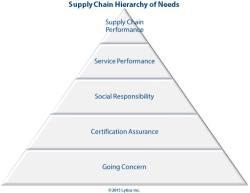In my last blog, I discussed how due diligence can be improved. Today we’ll explain how to ensure a component will meet standards, perform as expected, and be in supply when you need it.
These concerns stem from the second level of Lytica’s supply chain hierarchy of needs, which includes three elements:

- Certifications that the supplier and its products are in compliance with regulations and standards;
- Confirmation that the supplier’s product will perform consistently so that your own product certifications remain valid; and
- Assurance that the supplier’s supply chain performance will remain aligned with your needs.
Certification is a proof of conformance to requirements. Conformance to requirements is the definition of quality used by the latePhilip B. Crosby, a quality guru from the 60s, who promoted the cost of quality concept as a means of bringing management attention to the poor quality performance of the time. In my points above, the first is proof of compliance to government regulations and industry standards; the second and third are proof of quality systems.
Of course, compliance requirements to regulations vary from region to region and country to country. There are a variety of requirements regarding safety and the environment, such as RoHS, Reach, UL, FCC emissions, and conflict materials reporting, that must be met before products can be made or sold in a country. There are also restrictions on export and import. Each company must know, and be in compliance with, the regulations applicable to it.
Assurance of compliance to regulations is best served when reputable, accredited, third-party laboratories and agencies issue documentation confirming compliance. With reputable suppliers, this should be adequate; however, since reputable is not a globally defined standard, audits and sample verifications with new suppliers are worthwhile. Additionally, with counterfeiting issues prevalent, some system of component traceability is recommended.
Compliance testing is not a production process and is usually performed when a supplier or component is introduced into a new product. This new product’s compliance to its requirements (e.g. emissions standards) is likely only tested before product launch, even though each unit sold must be compliant. It is possible — in fact, highly probable — that suppliers will make changes to components to reduce costs.
These changes may alter the component’s performance in a manner that, while still meeting its specification, changes your product’s compliance. Silicon die shrinks, change to a crystal-etching process, or materials changes in a magnetics process are examples of this. Die shrinks increase speed, etching can change frequency harmonics, and materials changes in magnetics can change performance characteristics in subtle ways.
Change notice
It is important for suppliers to notify you of changes that may affect your product’s compliance so that you may assess their impact. Their quality system must be capable of providing such notifications while you must be able to prioritize and specify which type of change requires notification.
The examples above relate to a product change, but business process changes can also affect compliance; in this case, compliance to your expectations rather than those of a government agency. Your supply chain design has supplier alignment requirements to your product and customer delivery model; each supplier must meet these consistently.
It is possible that your certifications, such as ISO, require that your suppliers maintain their certifications. You may also have a policy requiring compliance with IPC, JEDEC, or EIA. As you fit a supplier into your supply chain design, seek proof that its business processes can support compliance reporting and will align with your requirements.
By Ken Bradley – Lytica Inc. Founder/Chairman/CTO



